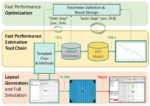Electronic engineers use advanced simulation tools to create virtual representations of complex electronic circuits. These “digital twins” streamline the circuit design process, accurately modeling silicon behavior and performance before physical fabrication. This article reviews the three primary circuit simulation categories: analog, digital, and mixed. It also discusses different simulation levels, such as block and chip, and […]
EDA
If you’re designing RFICs, here are some tools to consider
Radiofrequency ICs (RFICs) are found in consumer devices, portable electronics, automotive, military, and medical systems. They typically operate from several hundred MHz to multiple GHz. Those high frequencies present designers with significant layout challenges to ensure proper functioning, including the use of transmission line technology for efficient operation. This FAQ presents several options for RFIC […]
If you’re designing mixed-signal ICs, here are some tools to consider
Mixed-signal ICs are increasingly common in automotive, internet of Things (IoT), medical, industrial, consumer, and other applications. Designing mixed-signal ICs is more complex than simply designing an analog section and a digital section. There’s the interactions and interconnections between the sections, and the need to integrate software into the final solution. That makes designing mixed-signal […]
If you’re designing MEMS devices, here are some tools to consider
The uses for microelectromechanical systems (MEMS) devices have grown exponentially. Applications for MEMS technology include actuators, sensors, inertial measurement units (IMUs), energy harvesters, pumps, motors, oscillators, resonators, and more. They are used in all areas, from consumer to medical, military, and space. Two keys to the expansive uses of MEMS devices include the ability to […]
What are the elements of analog IC EDA tools?
Analog functions like sensor interfaces, signal conditioning, power management, and energy harvesting are needed in many applications. These functions are implemented with circuits like operational amplifiers, regulators, filters, sense amplifiers, low-noise amplifiers, phase-locked loops, analog-to-digital converters (ADCs), mixers, analog receiver front ends, and so on. These functions complement digital processing and can be implemented as […]
If you’re designing analog ICs, here are some tools to consider
Designing analog ICs can be a time-consuming and nit-picky process. As with the design of digital ICs, speed, power, and area (SPA) considerations are important. However, in the case of analog ICs, added challenges include gain, bandwidth, signal distortion, noise sensitivity, power supply sensitivity, thermal sensitivity, and more. All the major electronic design automation (EDA) […]
If you’re designing power ICs, here are some tools to consider
Power ICs cover a variety of functions, from high voltage application-specific ICs (HV-ASICs) to power management ICs (PMICs). Each type of power IC has unique design challenges and needs specific design tools. This FAQ reviews some of the challenges related to HV-ASICs for applications like gate drivers for power semiconductor devices, pin drivers for automatic […]
If you are working with sensors here are some tools to consider: Part 2
Sensor fusion is increasingly important across a range of applications including automotive, industrial, consumer, portable, medical systems and others. It can be challenging to sort out the design issues and identify the optimal solution. That’s where electronic design automation (EDA) tools are handy. The best choice of EDA tool or tools for a given project […]
If you are working with sensors here are some tools to consider: Part 1
Sensor fusion is increasingly important across a range of applications including automotive, industrial, consumer, portable, medical systems, and others. It can be challenging to sort out the design issues and identify the optimal solution. That’s where electronic design automation (EDA) tools are handy. The best choice of EDA tool or tools for a given project […]
If you are working with power management here are some tools to consider, part 2
Power management encompasses a range of power converter types and topologies and includes systems like motor drives, ac/dc power supplies, dc/dc converters, and battery chargers. Designing compact, cost-effective, and efficient power management systems is challenging and requires a combination of skills in high voltage and high current design, control loop optimization, mitigation of electromagnetic interference […]










